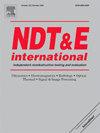尾波的拓扑数据分析,以分类微结构变异性
IF 4.5
2区 材料科学
Q1 MATERIALS SCIENCE, CHARACTERIZATION & TESTING
引用次数: 0
摘要
尾波是出现在超声信号后半部分的多次散射波。它们通常用于检测不同介质中的局部宏观结构变化。在这里,我们展示了尾波在表征材料中细微的微观结构变化方面的潜力,并证明了这些变化是以其波形的形状编码的。具体来说,我们利用拓扑数据分析(TDA)的一种工具——子层次持久同调(sublevel persistent homology)来量化由尾波函数值参数化的子层次集的连通分量。我们使用得到的持久性图来提取特征,用于对91级钢的不同显微组织进行分类。我们探索的基于持久性的特征是卡尔森坐标、帐篷函数和插值多项式。我们使用这些特征来训练分类器来识别底层微观结构,并将结果精度与传统的相关损失(LOCOR)相比较。结果表明,TDA方法在类间和类内分类中均优于LOCOR方法,3类分类的总体准确率在80%以上,2类分类的总体准确率在90%以上。这突出了尾波识别微结构的能力,以及TDA从波形中捕获亚波长特征的有效性。我们相信将尾波与基于tda的分析相结合可以为各种工业应用中的无损评价和微观结构表征提供有效的工具。本文章由计算机程序翻译,如有差异,请以英文原文为准。
Topological data analysis of coda waves to classify microstructural variability
Coda waves are multiply scattered waves appearing in the later portion of ultrasonic signals. They have been typically used for detecting local macrostructural variations in different media. Here we show the promising potential of coda waves for characterizing subtle microstructural variations in materials, and demonstrate that these variations are encoded in the shape of their waveforms. Specifically, we utilize sublevel persistent homology, a tool from Topological Data Analysis (TDA), to quantify the connected components of sublevel sets that are parameterized by coda waves’ function value. We use the resulting persistence diagrams to extract features for classifying different microstructures of Grade 91 steel. The persistence-based features that were explored are Carlsson Coordinates, Tent Functions, and Interpolating Polynomials. We use these features to train a classifier for identifying the underlying microstructure, and compare the resulting accuracy to its conventional Loss of Correlation (LOCOR) counterpart. The results suggest that TDA methods consistently outperformed LOCOR in both inter-class and intra-class classification, achieving overall accuracies above 80% for 3-class classification and over 90% for 2-class classification. This highlights the ability of coda waves to identify microstructures, and the effectiveness of TDA in capturing sub-wavelength features from the waveforms. We believe that combining coda waves with TDA-based analysis can provide an effective tool for non-destructive evaluation and microstructure characterization in various industrial applications.
求助全文
通过发布文献求助,成功后即可免费获取论文全文。
去求助
来源期刊

Ndt & E International
工程技术-材料科学:表征与测试
CiteScore
7.20
自引率
9.50%
发文量
121
审稿时长
55 days
期刊介绍:
NDT&E international publishes peer-reviewed results of original research and development in all categories of the fields of nondestructive testing and evaluation including ultrasonics, electromagnetics, radiography, optical and thermal methods. In addition to traditional NDE topics, the emerging technology area of inspection of civil structures and materials is also emphasized. The journal publishes original papers on research and development of new inspection techniques and methods, as well as on novel and innovative applications of established methods. Papers on NDE sensors and their applications both for inspection and process control, as well as papers describing novel NDE systems for structural health monitoring and their performance in industrial settings are also considered. Other regular features include international news, new equipment and a calendar of forthcoming worldwide meetings. This journal is listed in Current Contents.
 求助内容:
求助内容: 应助结果提醒方式:
应助结果提醒方式:


